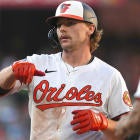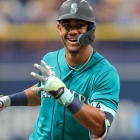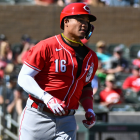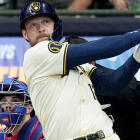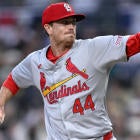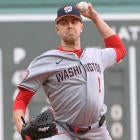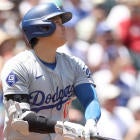Looking back at it, trying to go 10 deep at first and second base might have been a bit of a stretch. You have to have a fertile imagination to think Joe Terdoslavich and Scooter Gennett are going to be the difference in you winning and losing your dynasty league.
But if you can't find an outfield prospect who appeals to you in Fantasy, prospecting just isn't for you.
I've extended the list to 20 at this position, which is reasonable considering a baseball lineup features three times as many outfielders as any other position. So why not extend it to 30, you ask? It's a matter of stamina, both for the writer and the reader. Yeah, 20 may not be enough to hit all the dribs and drabs at the position, but it's enough to address the big names while still identifying some of the lesser-known short-term (Adam Eaton, Aaron Hicks and Evan Gattis) and long-term (Oswaldo Arcia, Gregory Polanco, Rymer Liriano) contributors.
Plus, you'll thank me for not going any further when you see the pitcher prospects piece later on. Let's just say you'll want a comfy chair for that one.
Note: This list has been adjusted for Fantasy purposes. Though long-term potential is a factor, it's arguably less important than the player's expected role in 2013. These prospects don't all profile as superstars, but they're the names most worth knowing in Fantasy right now.
1. Wil Myers, 22, Rays
Where
played in 2012: Double-A, Triple-A
Minor-league stats:
.314 BA, 37 HR, 109 RBI, .987 OPS, 61 BBs, 140 Ks
With Bryce Harper and Mike Trout already in the big leagues by late April, the prospect hounds turned their attention to Myers, the third of the big outfield prospects whose promotion seemed just a matter of time for the non-contending Royals. Not only had he bounced back from a disappointing 2011 in which he battled a knee injury, but he was finally putting up the big power numbers the scouts had long predicted for him (and while retaining his usual high on-base percentage, no less). But the Royals kept putting off the decision and putting off the decision until, eventually, the season was over. They then traded Myers to the Rays this offseason, which suggests they didn't think they had a need for him. OK, so they got a pretty nice haul in return, but when's the last time a rebuilding club gave up arguably the game's top prospect for any sort of haul? Whatever lack of appreciation the Royals showed for Myers last year the Rays are sure to correct this year. They certainly have an opening in their outfield, and they certainly have a need for offense. Most likely, they'll plug him into the lineup right away, and if he follows Harper's and Trout's lead, he'll deliver right away. He does come with risk, as all young players do, but Myers' upside makes him worthy of being a top-40 outfielder.
2. Oscar Taveras, 20, Cardinals
Where
played in 2012: Double-A
Minor-league stats: .321 BA, 23
HR, 94 RBI, .953 OPS, 42 BBs, 56 Ks
Though already considered a top prospect going into last season, Taveras' performance against Double-A competition as a 19-year-old caused the hype on him to soar, with some even calling for his promotion to the big club even though the Cardinals outfield was overstocked to begin with. Taveras never did get that call to the majors -- or even Triple-A -- but the hype on him remains at an all-time high. He's sure to get a long look in spring training as the Cardinals assess his major-league readiness. Even though their outfield is still beyond capacity, with on-base specialist Matt Carpenter confined to a bench spot for now, their corner options -- Matt Holliday and Carlos Beltran -- aren't getting any younger. In particular, Beltran, with his degraded knees, might be due for a reduction in playing time in his age-36 season after he wore down in the second half last season. Or, just as likely, he could land on the DL at some point. The bottom line is the Cardinals have every excuse to make at-bats for Taveras if he gets off to a hot start in the minors. With his low strikeout rate making him a near certainty for a high batting average (to go along with middle-of-the-order power), he might even be worth a draft-and-stash in mixed leagues.
3. Jackie Bradley, 22, Red Sox
Where
played in 2012: Class A, Double-A
Minor-league stats: .315
BA, 9 HR, 24 SB, 42 2Bs, .911 OPS, 87 BBs, 89 Ks
Bradley's first full professional season showed exactly why he was the star of the University of South Carolina's back-to-back national championship teams in 2010 and 2011. After his speed, extra-base pop and stellar batting eye (he had 52 walks to 40 strikeouts during the stint) led to a .359 batting average and .480 on-base percentage (not to be confused with slugging percentage) in 234 at-bats at Class A Salem, the Red Sox promoted him to Double-A Portland midway through the season, where he actually popped two-thirds of his homers while maintaining his high walk rate. He did slow down in enough other areas that the Red Sox will surely send him back to Portland for the start of 2013, but considering he'll be 23 after opening day, his time is coming. With Jacoby Ellsbury ticketed for free agency after the season, the Red Sox may want to get a sneak peak at everything Bradley brings to the table, making him a candidate for a midseason call-up and a prospect well worth monitoring even in single-season mixed leagues. Remember how valuable Carl Crawford was in his prime? Bradley has the potential for those kinds of numbers, only with an even better on-base percentage.
4. Christian Yelich, 21, Marlins
Where
played in 2012: Rookie, Class A
Minor-league stats: .329
BA, 12 HR, 20 SB, .918 OPS, 49 BBs, 85 Ks
Named its minor-league player of the year two years in a row, Yelich has been the jewel of the Marlins' system since Giancarlo Stanton came up in 2010. And in terms of pure talent, he isn't far off. No, he doesn't project to have Stanton's other-worldly power, but he's a more polished hitter, having batted .330 in his first stop at high Class A, with enough speed to make him a future 20-20 man, if not better. His all-around offensive prowess is similar to that of Carlos Gonzalez, only without the free-swinging tendencies, as his .402 on-bsae percentage last year shows. Considering he's only 21, the Marlins don't need to rush Yelich, but after trading most of their team to the Blue Jays this offeason, they may need to speed up his timetable just to give fans something to look forward to. If Yelich continues to progress at the rate he has so far, he'll force a promotion before it even becomes a dilemma. You probably shouldn't draft him outside of long-term keeper leagues, but don't be surprised if he makes an appearance at some point in 2013.
5. George Springer, 23, Astros
Where
played in 2012: Class A, Double-A
Minor-league stats: .302
BA, 24 HR, 32 SB, .908 OPS, 62 BBs, 156 Ks
The 11th overall pick in the 2011 draft, Springer didn't take long to make an impression, demonstrating his five-tool ability between two stop in his first full professional season. True, he did most of his damage in the heavy-hitting California League and struggled after a late-season promotion to Double-A Corpus Christi, but this isn't a player who caught everyone by surprise, as so many of the big-numbers guys in the California League do. This is a player who the scouts have compared to Matt Kemp from the day he was drafted. Right now, Springer's biggest shortcoming is a high strikeout rate, and it might be the reason to Astros opt to keep him in the minors for another full season, even at age 23. But if he makes quick adjustments in the upper levels of the minors, a midseason arrival isn't out of the question. It's not like anyone is blocking him a Houston. Springer is worth stashing in AL-only leagues just for that possibility, and he's obviously a must-have in long-term keeper leagues.
6. Adam Eaton, 24, Diamondbacks
Where
played in 2012: Double-A, Triple-A, majors
Minor-league stats:
.375 BA, 7 HR, 130 R, 44 SB, .978 OPS, 59 BBs, 76 Ks
Major-league
stats: .259 BA (85 at-bats), 2 HR, 2 SB, .794 OPS, 14 BBs, 15 Ks
Even as he continued his onslaught of minor-league pitching, hitting .375 with a .456 on-base percentage between Double- and Triple-A last year, the scouts have been slow to come around on Eaton. True, he has benefited from favorable hitting environments, such as Class A Visalia of the California League and Triple-A Reno of the Pacific Coast league, but he's been a .300 hitter at every stop up the ladder. The Diamondbacks are certainly believers, promoting him to serve as their leadoff hitter while still technically in the playoff hunt late last year. In fact, some have said he's the biggest reason why the Diamondbacks entertained trade offers for Justin Upton in the offseason. Eaton's power potential is somewhat in question because of where he played his minor-league ball, but he certainly has enough to pile up doubles and triples, given his speed. And as an on-base threat, he's second to none. He compiled a .382 mark despite a .259 batting average during his September stint last year. Penciled in as the Diamondbacks' center fielder to begin 2013, Eaton will be worth a late-round look in Rotisserie league just for the number of steals he figures to contribute. Given his potential for walks and extra-base hits, he'll be worth even more than that in Head-to-Head points leagues.
7. Jorge Soler, 21, Cubs
Where
played in 2012: Rookie, Class A
Minor-league stats: .299
BA (134 at-bats), 5 HR, 12 SB, .832 OPS, 12 BBs, 19 Ks
The hype on Soler heading into 2012 wasn't quite as big as the hype on fellow Cuban defector Yoenis Cespedes, but that's at least partially because Cespedes was already major-league ready. Soler still needs some time to develop, but considering the nine-year deal the Cubs gave him last June, he has a projectable skill set that should make him a Fantasy stud in due time. He certainly got off on the right foot in the lower levels of the minors late last season, actually improving his production with a .338 batting average when he made the jump from Rookie ball to Class A for his final 80 at-bats. And that's not even his best tool. Some within the Cubs organization have compared his power to Sammy Sosa's. The Cubs have been equally impressed with his pitch selection and patience, so he'll likely have a leg up on the competition as he begins to play in the upper levels of the minors. If it shows up his numbers, the Cubs might not be able to prevent him from ascending all the way to the big leagues. Considering he's only 21, they could hold him back if they so choose, but the bottom line is Soler is more polished than most prospects his age. In addition to being a must-own in long-term keeper leagues, he's stashable in NL-only formats.
8. Byron Buxton, 19, Twins
Where
played in 2012: Rookie
Minor-league stats: .248 BA (165
at-bats), 5 HR, 11 SB, .448 SLG, .792 OPS
No doubt, Buxton is a physical specimen who profiles as a five-tool player if everything breaks as it should, but right now, he leans more toward speed than power. You see the potential for power, though. In addition to his five home runs, he had 10 doubles and four triples in 165 at-bats in Rookie ball last year. Still, at age 19, he's a long way from reaching his full potential. Many scouts thought he, and not No. 1 overall pick Carlos Correa, was the best player in the 2012 draft, and for that reason alone, he's a must-have in long-term keeper leagues. Just understand that you'll have to wait a few years for him to develop into an Andrew McCutchen-like player.
9. Oswaldo Arcia, 21, Twins
Where
played in 2012: Class A, Double-A
Minor-league stats: .320
BA, 17 HR, 98 RBI, .928 OPS, 51 BBs, 107 Ks
A fringe prospect when he first began his professional career as a 17-year-old in 2008, Arcia has made considerable progress since then, adding bulk to his frame to become a one-man wrecking crew in the minors. Already established as a .300 hitter, his pop has translated to the upper levels of the minors, giving him legitimate middle-of-the-order potential. His batting eye is nothing special, but as well as he hits, he doesn't need an especially high walk rate. Because his rise up the prospect rankings has been so abrupt, you might be able to get Arcia for a reasonable price in long-term keeper leagues, so pay extra close attention to him there. A 2013 promotion isn't out of the question, but as patient as the Twins normally are with their top prospects, they would probably prefer to see him finish the year at Triple-A. Still, if you have room for Arcia in an AL-only league, he's a candidate to stash.
10. Bubba Starling, 20, Royals
Where
played in 2012: Rookie
Minor-league stats: .275 BA (200
at-bats), 10 HR, 10 SB, .371 OBP, .856 OPS
Because he played three sports (rather than focusing just on baseball) in high school, Starling is a bit of a project for the Royals, but his tools are off the charts, as you might expected for the player drafted fifth overall in 2011. The Royals didn't turn him loose at the beginning of 2012, but when he did get his shot in Rookie ball later in the year, his power and speed were both on full display. Surprisingly, he drew a high number of walks as well, producing a .371 on-base percentage to go along with his .275 batting average, but he hasn't figured out how to make consistent contact, striking out 70 times in 200 at-bats. If and when he corrects that aspect of his game, he'll be arguably the top prospect in baseball. But we're probably years from seeing that happen. If you play in a long-term keeper league, you can't let Starling go unowned, but he's irrelevant in single-season formats.
11. Gregory Polanco, 21, Pirates
Where
played in 2012: Class A
Minor-league stats: .325 BA, 16
HR, 40 SB, .910 OPS, 44 BBs, 64 Ks
What's with the water in West Virginia? Not only did shortstop Alen Hanson emerge as a top prospect there last year, but outfielder Gregory Polanco did as well, adding newfound power to his already game-changing speed and stellar batting eye. Having signed as a 17-year-old out of the Dominican Republic, perhaps he was simply overwhelmed in his first three years in the minors, when he produced a .235 batting average. Whatever the reason, he suddenly made good on all the tools that caught the Pirates' notice back in 2009. His basic stats -- which include a .325 batting average, 16 home runs and 40 stolen bases -- are good enough on their own, but the fact he struck out only 64 times in 437 at-bats suggests he may not have many areas left to improve. The risk of him being a one-year wonder is minimal enough that he's worth owning in all long-term keeper leagues. If he rises to the upper levels of the minors this year, he could be ready to debut early in 2014.
12. Yasiel Puig, 22, Dodgers
Where
played in 2012: Rookie, Class A
Minor-league stats: .354
BA (82 at-bats), 5 HR, 8 SB, 1.076 OPS, 12 BBs, 15 Ks
Among the big-name Cuban defectors last year -- Yoenis Cespedes and Jorge Soler being the others -- Puig was considered the least enticing, but he got the most money of the three, kicking off what would become an unprecedented spending spree for the Dodgers. When he finally got a chance to play in the minors last year, he more or less lived up to the price tag, actually outperforming Soler with a .354 batting average and 1.076 OPS between two stops. His physique predisposes him to weight gain, which is part of what kept the hype on him to a minimum before he signed last season. Hey, he hadn't played baseball in a year. Conditioning sort of took a back seat. But when he did get in playing shape, he showed arguably as much potential as Soler, even swiping eight bases in 23 games. Conditioning will remain an issue for him, which is why he still isn't as highly regarded as Soler, but at age 22, he doesn't need to keep the weight off for long to break through in the big leagues. If nothing else, Puig should at least make an impact as a power hitter, with room in his profile for more than that. No doubt, he's a player to stash in NL-only leagues.
13. Aaron Hicks, 23, Twins
Where
played in 2012: Double-A
Minor-league stats: .286 BA, 13
HR, 32 SB, 11 3Bs, .844 OPS, 79 BBs, 116 Ks
With a declining batting average and yet-to-develop power, Hicks' prospect status took a serious hit at this time last year, but it's come roaring back after a breakout year in which he nearly doubled his career highs in home runs and stolen bases. The emergence coincided with his promotion to Double-A -- widely considered the most significant step up the minor-league ladder -- which suggests it was more a matter of him growing into his tools than beating up on inferior competition. It certainly convinced the Twins, who traded both Denard Span and Ben Revere this offseason, presumably to make way for Hicks. Hicks will have to beat out 27-year-old Darin Mastroianni for the job this spring, but even if he doesn't, his ascension is probably just a matter of him spending a few weeks at Triple-A. Because Hicks' name has been synonymous with disappointment in recent years, some Fantasy owners may be slow to come around to him, but even during those years when he struggled, his walk rate was among the best in the minors. Even if he disappoints in batting average and home runs as a rookie, he'll get on base enough to factor in steals. Hicks' potential isn't quite that of fellow Twins prospects Byron Buxton and Oswaldo Arcia, but because his time is now, he's worth a late-round look even in mixed leagues.
14. Michael Choice, 23, Athletics
Where
played in 2012: Double-A
Minor-league stats: .287 BA (359
at-bats), 10 HR, .779 OPS, 33 BBs, 88 Ks
Choice has rated among the top outfield prospects since the Athletics selected him 10th overall in 2010, but he also hasn't progressed much during that time. He hits for power, but he always hit for power. He still whiffs at a high rate and hasn't upped his batting average from the mid-.280s. Injuries deserve some of the blame for his lack of development -- he broke his left hand just when some of the adjustments he had made to his swing were beginning to pay off last July -- but at age 23, he may have reached a point where he isn't going to get much better. The good news is his steady production each step up the ladder suggests he should have a smooth transition to the majors when the time comes. It's just that he might end up being an all-or-nothing slugger who offers no better than a suspect batting average. Because he still has a fleeting hope of developing into more, Choice remains a decent option in long-term keeper leagues. Given his potential to contribute as a midseason call-up, you wouldn't want to overlook him in AL-only leagues.
15. Mason Williams, 21, Yankees
Where
played in 2012: Class A
Minor-league stats: .298 BA (359
at-bats), 11 HR, 20 SB, .820 OPS, 24 BBs, 47 Ks
Williams doesn't have the big, sturdy frame that you'll typically find among outfield prospects, but make no mistake: The 21-year-old can hit. He makes consistent contact, striking out just 47 times in 359 at-bats between two levels of Class A last year, and he began to show some power with 11 home runs during that same stretch. He should grow into his 20-homer, 40-steal potential as he continues to add muscle to his frame, making him an ideal candidate to take over in center field when Curtis Granderson becomes a free agent after the 2013 season. Of course, Williams has to prove he's ready first, and to do that, he'll have to overcome a torn labrum in his left shoulder that shut him down last July. Plus, even if his bat-on-ball ability earns him a role next spring, his smallish build could limit his power in the early going, preventing him from meeting his full potential until he reaches his mid-20s. In other words, even though he may be only a year from being major-league ready, Williams may not make the immediate impact of a Wil Myers or Oscar Taveras. His potential for disaster is relatively minimal, though, so you'll want to lock him up for the long haul in dynasty leagues.
16. Rymer Liriano, 21, Padres
Where
played in 2012: Class A, Double-A
Minor-league stats: .280
BA, 8 HR, 32 SB, .767 OPS, 41 BBs, 119 Ks
Long considered one of the higher-upside players in the Padres system, Liriano has begun to make the most of his tools in recent years. His progression has been a slow one, with his production taking an initial hit each step up the ladder, but when given enough time at a level, he produces up to expectations. Already an accomplished base-stealer, Liriano's power figures to improve as he matures. His pitch recognition keeps the Padres optimistic in the meantime. A 2013 promotion is hard to envision for Liriano, but as highly as the scouts regard him, he's worthy of your trust in a long-term keeper league.
17. Tyler Austin, 21, Yankees
Where
played in 2012: Rookie, Class A, Double-A
Minor-league stats:
.322 BA, 17 HR, 92 R, 80 RBI, 23 SB, .960 OPS
Getting a chance to play full-season ball for the first time last year, Austin has more than lived up to expectations, maintaining a batting average well over .300 during what was nearly a 20-20 campaign. He isn't as hyped as fellow Yankees prospect Mason Williams, presumably because he isn't as "toolsy," but he had better numbers last year and has already gotten a taste of Double-A. Confined to a corner outfield spot, his path to the majors isn't as clear as that of Williams or even Slade Heathcott, another high-upside outfielder in the Yankees system, so one misstep could cause Austin to get lost in the shuffle. But if he continues to hit like he has in his first two minor-league seasond, he could be the first of those three to get the call, potentially even in 2013. Given Brett Gardner's injury history and Ichiro Suzuki's 39 years of age, Austin is a prospect you'll want to have on standby in AL-only leagues. He's not a bad pick for long-term keeper leagues either, even if he's further down the list than some of his fellow Yankees farmhands.
18. Avisail Garcia, 21, Tigers
Where
played in 2012: Class A, Double-A, majors
Minor-league stats:
.299 BA, 14 HR, 23 SB, .789 OPS, 18 BBs, 95 Ks
Major-league stats:
.319 BA (47 at-bats), 0 HR, 0 SB, .692 OPS, 3 BBs, 10 Ks
Desperate to find a platoon partner for the left-handed-hitting Quintin Berry late last season, the Tigers turned to the 21-year-old Garcia, who was having a breakthrough season in the minors, maintaining a high batting average even with a midseason promotion to Double-A Erie. Garcia wasn't bad in the role, but he didn't live up to the nickname "Little Miggy" either. While a young Miguel Cabrera helped guide the Marlins to a World Series title in 2003 with a few clutch homers during the postseason, Garcia didn't hit a single home run in either the regular season or postseason. In fact, he had only one extra-base hit -- a double during the ALCS -- in a combined 80 at-bats. You see the problem there? Garcia has to hit for power to be an impact player in the majors. He has terrible plate discipline and a strikeout rate that likely precludes him from being a steady .300 hitter. Granted, at age 21, he still has time to emerge as a 20-homer threat, but he's not there yet. The Tigers' signing of Torii Hunter this offseason gives Garcia an opportunity to continue honing his skills in the minors. With fellow prospect Nick Castellanos now also playing the outfield, Garcia isn't necessarily next in line, so he's just a deeper sleeper in AL-only leagues.
19. Brett Jackson, 24, Cubs
Where
played in 2012: Triple-A, majors
Minor-league stats: .256
BA, 15 HR, 27 SB, 12 3Bs, .817 OPS, 47 BBs, 158 Ks
Major-league
stats: .175 BA (120 at-bats), 4 HR, 0 SB, .644 OPS, 22 BBs, 59 Ks
We should have all seen this coming, right? Jackson, trailed by one glowing scouting report after another, got the call to the majors last August and promptly bombed, batting .175 with a .644 OPS. Of course, you wouldn't expect much more than that from a player who struck out every other at-bat, would you? And really, it was every other at-bat. Of his 120 at-bats, 59 resulted in strikeouts. The most surprising part is that it was a surprise to so many. For all he did well in the minor leagues, one thing Jackson didn't do was make consistent contact. Prior to his call-up, he had 158 strikeouts in 407 at-bats for Triple-A Iowa. Clearly, it's a chronic issue, and at age 24, he's probably beyond the point where he'll grow out of it. So, then, can he survive it? Are his tools enough to sustain him if he's giving away that many at-bats? Clearly, the Cubs want to take more time to figure it out, which is why they brought in Nate Schierholtz this offseason. Another mediocre performance in the Pacific Coast League -- where a .256 batting average and .817 OPS are no cause for excitement, really -- could make Jackson an afterthought in Chicago. His proximity to the majors is the main reason he's still worth drafting in NL-only leagues.
20. Evan Gattis, 26, Braves
Where
played in 2012: Rookie, Class A, Double-A
Minor-league stats:
.305 BA (272 at-bats), 18 HR, .995 OPS, 31 BBs, 43 Ks
Gattis isn't your average prospect. For starters, he's 26, making him a man among boys in the lower levels of the minors. That's right: the lower levels. He didn't move up to Double-A until the second half last year, which isn't so surprising when you consider he's played only three years of professional baseball. Drug use and clinical depression sidetracked him for four years after high school, causing him to take odd jobs all across the country rather than play college ball. But now, he's a baseball player again -- and by the look of his numbers, a pretty good one. His power potential is off the charts, but his polish is in question after spending so much time away from the game. Sure, his minor-league numbers look great, but was it a case of an older player beating up on lesser competition? He hit only .258 in 182 at-bats after his promotion to Double-A. Plus, he's having to learn a new position, transitioning to the outfield after beginning his career at catcher. Clearly, Gattis has a few obstacles standing in his way, but if he's able to overcome them and earn even a part-time role in left field for the Braves, he could be a surprising contributor of home runs. He's a sneaky stash in NL-only leagues for that reason.
Stay in touch with the most passionate Fantasy staff in the business by following us on Twitter @CBSFantasyBB or Scott White at @CBSScottWhite . You can also e-mail us at fantasybaseball@cbsinteractive.com .








